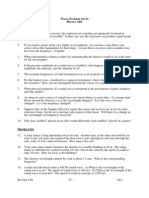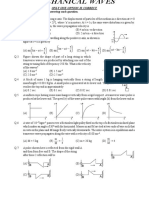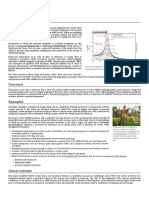Physics I Problems PDF
Physics I Problems PDF
Uploaded by
BOSS BOSSCopyright:
Available Formats
Physics I Problems PDF
Physics I Problems PDF
Uploaded by
BOSS BOSSOriginal Title
Copyright
Available Formats
Share this document
Did you find this document useful?
Is this content inappropriate?
Copyright:
Available Formats
Physics I Problems PDF
Physics I Problems PDF
Uploaded by
BOSS BOSSCopyright:
Available Formats
548
CHAPTER 16 Sound and Hearing
be the tension of the string to produce the desired effect? (b) What
happens to the sound produced by the instrument if the tension is
changed to twice the value calculated in part (a)? (c) For the tension calculated in part (a), what other harmonics of the string, if
any, are in resonance with standing waves in the air column?
16.65 . An organ pipe has two successive harmonics with frequencies 1372 and 1764 Hz. (a) Is this an open or a stopped pipe?
Explain. (b) What two harmonics are these? (c) What is the length
of the pipe?
16.66 . Longitudinal Standing Waves in a Solid. Longitudinal standing waves can be produced in a solid rod by holding it at
some point between the ngers of one hand and stroking it with the
other hand. The rod oscillates with antinodes at both ends. (a) Why
are the ends antinodes and not nodes? (b) The fundamental frequency can be obtained by stroking the rod while it is held at its
center. Explain why this is the only place to hold the rod to obtain
the fundamental. (c) Calculate the fundamental frequency of a
steel rod of length 1.50 m (see Table 16.1). (d) What is the next
possible standing-wave frequency of this rod? Where should the
rod be held to excite a standing wave of this frequency?
16.67 .. A long tube contains air at a pressure of 1.00 atm and a
temperature of 77.0C. The tube is open at one end and closed at
the other by a movable piston. A tuning fork near the open end is
vibrating with a frequency of 500 Hz. Resonance is produced
when the piston is at distances 18.0, 55.5, and 93.0 cm from the
open end. (a) From these measurements, what is the speed of
sound in air at 77.0C? (b) From the result of part (a), what is the
value of g? (c) These data show that a displacement antinode is
slightly outside of the open end of the tube. How far outside is it?
16.68 ... The frequency of the note F4 is 349 Hz. (a) If an organ
pipe is open at one end and closed at the other, what length must it
have for its fundamental mode to produce this note at 20.0C? (b)
At what air temperature will the frequency be 370 Hz, corresponding to a rise in pitch from F to F-sharp? (Ignore the change in
length of the pipe due to the temperature change.)
16.69 . A standing wave with a frequency of 1100 Hz in a column of methane 1CH42 at 20.0C produces nodes that are 0.200 m
apart. What is the value of g for methane? (The molar mass of
methane is 16.0 g>mol.)
16.70 .. Two identical loud- Figure P16.70
speakers are located at points A
and B, 2.00 m apart. The loudA
speakers are driven by the same
amplier and produce sound
2.00 m
waves with a frequency of 784
Hz. Take the speed of sound in
air to be 344 m>s. A small
B
C
microphone is moved out from
point B along a line perpendicux
lar to the line connecting A and
B (line BC in Fig. P16.70). (a)
At what distances from B will there be destructive interference?
(b) At what distances from B will there be constructive interference? (c) If the frequency is made low enough, there will be no
positions along the line BC at which destructive interference
occurs. How low must the frequency be for this to be the case?
16.71 . Wagnerian Opera. A man marries a great Wagnerian
soprano but, alas, he discovers he cannot stand Wagnerian opera.
In order to save his eardrums, the unhappy man decides he must
silence his larklike wife for good. His plan is to tie her to the front
of his car and send car and soprano speeding toward a brick wall.
This soprano is quite shrewd, however, having studied physics in
her student days at the music conservatory. She realizes that this
wall has a resonant frequency of 600 Hz, which means that if a
continuous sound wave of this frequency hits the wall, it will fall
down, and she will be saved to sing more Isoldes. The car is heading toward the wall at a high speed of 30 m>s. (a) At what frequency must the soprano sing so that the wall will crumble?
(b) What frequency will the soprano hear reected from the wall
just before it crumbles?
16.72 .. A bat ies toward a wall, emitting a steady sound of frequency 1.70 kHz. This bat hears its own sound plus the sound
reected by the wall. How fast should the bat y in order to hear a
beat frequency of 10.0 Hz?
16.73 .. CP A person leaning over a 125-m-deep well accidentally drops a siren emitting sound of frequency 2500 Hz. Just
before this siren hits the bottom of the well, nd the frequency and
wavelength of the sound the person hears (a) coming directly from
the siren and (b) reected off the bottom of the well. (c) What beat
frequency does this person perceive?
16.74 ... BIO Ultrasound in Medicine. A 2.00-MHz sound
wave travels through a pregnant womans abdomen and is
reected from the fetal heart wall of her unborn baby. The heart
wall is moving toward the sound receiver as the heart beats. The
reected sound is then mixed with the transmitted sound, and 72
beats per second are detected. The speed of sound in body tissue is
1500 m>s. Calculate the speed of the fetal heart wall at the instant
this measurement is made.
16.75 .. The sound source of a ships sonar system operates at a
frequency of 22.0 kHz. The speed of sound in water (assumed to
be at a uniform 20C) is 1482 m>s. (a) What is the wavelength of
the waves emitted by the source? (b) What is the difference in frequency between the directly radiated waves and the waves
reected from a whale traveling directly toward the ship at
4.95 m>s? The ship is at rest in the water.
16.76 . CP A police siren of frequency siren is attached to a
vibrating platform. The platform and siren oscillate up and down
in simple harmonic motion with amplitude Ap and frequency p.
(a) Find the maximum and minimum sound frequencies that you
would hear at a position directly above the siren. (b) At what point
in the motion of the platform is the maximum frequency heard?
The minimum frequency? Explain.
16.77 ... BIO Horseshoe bats (genus Rhinolophus) emit sounds
from their nostrils and then listen to the frequency of the sound
reected from their prey to determine the preys speed. (The
horseshoe that gives the bat its name is a depression around the
nostrils that acts like a focusing mirror, so that the bat emits sound
in a narrow beam like a ashlight.) A Rhinolophus ying at speed
vbat emits sound of frequency bat ; the sound it hears reected
from an insect ying toward it has a higher frequency refl.
(a) Show that the speed of the insect is
vinsect = vc
refl 1v - vbat2 - bat 1v + vbat2
frefl 1v - vbat2 + bat 1v + vbat2
where v is the speed of sound. (b) If bat = 80.7 kHz, refl =
83.5 kHz, and vbat = 3.9 m>s, calculate the speed of the insect.
16.78 .. (a) Show that Eq. (16.30) can be written as
R = S a1 -
v 1>2
v -1>2
b a1 + b
c
c
(b) Use the binomial theorem to show that if v V c, this is
approximately equal to
You might also like
- JBL Audio Engineering for Sound ReinforcementFrom EverandJBL Audio Engineering for Sound ReinforcementRating: 5 out of 5 stars5/5 (2)
- Doppler (Sound) WorksheetDocument3 pagesDoppler (Sound) WorksheetMohamed Jameel0% (2)
- Final Term Sem 1 0708Document7 pagesFinal Term Sem 1 0708jojolim18No ratings yet
- Sound (Multiple Choice) QP PDFDocument24 pagesSound (Multiple Choice) QP PDFnss100% (1)
- Sound Waves PDFDocument13 pagesSound Waves PDFJuan Pablo Chacana BurchardNo ratings yet
- Chapter 12 Test Bank PhysicsDocument13 pagesChapter 12 Test Bank PhysicsCarl Weinfield0% (1)
- Suggested ProblemsDocument4 pagesSuggested ProblemsJuan PadronNo ratings yet
- Physics I Problems PDFDocument1 pagePhysics I Problems PDFBOSS BOSSNo ratings yet
- S.6 PhysicsDocument4 pagesS.6 Physicsjian mne jNo ratings yet
- Phy094 Tutorial 10 QDocument3 pagesPhy094 Tutorial 10 QJoshua FowlerNo ratings yet
- Physics I Problems PDFDocument1 pagePhysics I Problems PDFBOSS BOSSNo ratings yet
- Waves and Sounds Questions With Answers.Document13 pagesWaves and Sounds Questions With Answers.micheal_cksNo ratings yet
- Physics I Problems PDFDocument1 pagePhysics I Problems PDFBOSS BOSSNo ratings yet
- Name Test Chapter 12 Sound 2010Document10 pagesName Test Chapter 12 Sound 2010zdbsNo ratings yet
- Waves Problems.2cDocument2 pagesWaves Problems.2csanashamsNo ratings yet
- CH 6 - Problems 2023-12-27 22 - 14 - 58Document2 pagesCH 6 - Problems 2023-12-27 22 - 14 - 58rb8q9sz8hrNo ratings yet
- Serway ExercisesDocument6 pagesSerway Exercisesyahiawork11No ratings yet
- CH 14Document13 pagesCH 14eman abdulghanyNo ratings yet
- Class 9 Science Mark Type Questions CH - 11 - SOUNDDocument41 pagesClass 9 Science Mark Type Questions CH - 11 - SOUNDSiddhartha PramanickNo ratings yet
- Pengenalan Gempa BumiDocument5 pagesPengenalan Gempa BumiPesta SigalinggingNo ratings yet
- Physics 6B Ch12worksheet SolutionsDocument2 pagesPhysics 6B Ch12worksheet SolutionsMaher TrabelsiNo ratings yet
- TB Chapter14 PDFDocument15 pagesTB Chapter14 PDFsuryapmohantyNo ratings yet
- Sound Waves Practice Problems 2013 01 17Document11 pagesSound Waves Practice Problems 2013 01 17ChristineNo ratings yet
- Microsoft Word Chapter17Document13 pagesMicrosoft Word Chapter17om123456789No ratings yet
- Sound Waves Problems PDFDocument16 pagesSound Waves Problems PDFsoumengoswami10No ratings yet
- Waves - 3Document2 pagesWaves - 3Shiva Ram Prasad PulagamNo ratings yet
- Sound: Answer All QuestionsDocument18 pagesSound: Answer All QuestionsNasser Alsowyan0% (1)
- PSI AP Physics 1: Sound Waves Practice ProblemsDocument16 pagesPSI AP Physics 1: Sound Waves Practice ProblemsAlexa AquinoNo ratings yet
- Sound WorksheetDocument2 pagesSound WorksheetkNo ratings yet
- Sound WavesDocument13 pagesSound WavesAndrewKiNo ratings yet
- 13a-Waves and Optics MC Practice Problems - Section ADocument12 pages13a-Waves and Optics MC Practice Problems - Section AGhazi DallyNo ratings yet
- Waves On String and Sound 30-10-2020Document5 pagesWaves On String and Sound 30-10-2020KARRA ASHISH REDDYNo ratings yet
- Physics I Problems PDFDocument1 pagePhysics I Problems PDFBOSS BOSSNo ratings yet
- Waves and Sound PacketDocument16 pagesWaves and Sound PacketKaito EspinaNo ratings yet
- Wave Sound: Physics Grade 8Document3 pagesWave Sound: Physics Grade 8Fuadi Anwar WirawanNo ratings yet
- Answer Key DT Superposition of Waves Set BDocument6 pagesAnswer Key DT Superposition of Waves Set Bdivyakatha266No ratings yet
- AcousticDocument13 pagesAcousticritaempalmadoNo ratings yet
- Questions About WavesDocument3 pagesQuestions About WavesAlfred100% (1)
- CH 16Document46 pagesCH 16Kathleen YoungNo ratings yet
- Periodic SHM RADocument10 pagesPeriodic SHM RADetective ConanNo ratings yet
- Unit One Sound Wave Level s6 Excercises 2023 2024Document14 pagesUnit One Sound Wave Level s6 Excercises 2023 2024dannydylan127No ratings yet
- Physics: Waves + Sound + Light + Optics + AtomsDocument4 pagesPhysics: Waves + Sound + Light + Optics + AtomsvtendeanNo ratings yet
- Example 8 1 SoundDocument27 pagesExample 8 1 Soundkirki pNo ratings yet
- Hapter: Conceptual ProblemsDocument16 pagesHapter: Conceptual ProblemsadelNo ratings yet
- Sound PDFDocument4 pagesSound PDFB.V100% (1)
- Chapter 16Document8 pagesChapter 16Mircea PanteaNo ratings yet
- Tutorial Sheet 3 - SOUND WAVESDocument1 pageTutorial Sheet 3 - SOUND WAVESlitebele litebeleNo ratings yet
- D4 SoundDocument2 pagesD4 Soundacademic.sinotifNo ratings yet
- AcousticDocument2 pagesAcousticsergio.moncada.munNo ratings yet
- 06a BunyiDocument31 pages06a BunyiPra TamaNo ratings yet
- Lecture 5 L.O 1 Part 2 QuestionsDocument5 pagesLecture 5 L.O 1 Part 2 QuestionssunydayformeNo ratings yet
- Final Exam Questions #9 - SoundDocument5 pagesFinal Exam Questions #9 - Soundanonslu2012No ratings yet
- Examview Waves and Sound Practice Test4Document9 pagesExamview Waves and Sound Practice Test4Tajay Billings100% (1)
- ExamView - Waves and Sound - Practice TestDocument9 pagesExamView - Waves and Sound - Practice TestMohan RajNo ratings yet
- Figure Shown The Shape of Part of A Long String in Which Transverse Waves Are Produced by Attaching One End of The String To Tuning Fork of Frequency 250 HZDocument21 pagesFigure Shown The Shape of Part of A Long String in Which Transverse Waves Are Produced by Attaching One End of The String To Tuning Fork of Frequency 250 HZharshanauocNo ratings yet
- 1.6 Sound WavesDocument16 pages1.6 Sound WavesIshraqi Ilyas100% (1)
- Harmonograph: A Visual Guide to the Mathematics of MusicFrom EverandHarmonograph: A Visual Guide to the Mathematics of MusicRating: 1 out of 5 stars1/5 (4)
- Pipes of the Church Organ - A Selection of Classic Articles on Organ Design and ConstructionFrom EverandPipes of the Church Organ - A Selection of Classic Articles on Organ Design and ConstructionNo ratings yet
- Voice Leading: The Science behind a Musical ArtFrom EverandVoice Leading: The Science behind a Musical ArtRating: 5 out of 5 stars5/5 (2)
- CBSE Class 1 English WorksheetDocument1 pageCBSE Class 1 English WorksheetBOSS BOSSNo ratings yet
- CBSE Class 1 English WorksheetDocument2 pagesCBSE Class 1 English WorksheetBOSS BOSS100% (1)
- CBSE Class 1 English WorksheetsDocument1 pageCBSE Class 1 English WorksheetsBOSS BOSSNo ratings yet
- CBSE Class 1 English WorksheetDocument1 pageCBSE Class 1 English WorksheetBOSS BOSSNo ratings yet
- CBSE Class 1 English WorksheetDocument1 pageCBSE Class 1 English WorksheetBOSS BOSSNo ratings yet
- CBSE Class 1 English WorksheetDocument1 pageCBSE Class 1 English WorksheetBOSS BOSSNo ratings yet
- CBSE Class 1 English WorksheetDocument1 pageCBSE Class 1 English WorksheetBOSS BOSSNo ratings yet
- CBSE Class 1 English WorksheetsDocument1 pageCBSE Class 1 English WorksheetsBOSS BOSSNo ratings yet
- CBSE Class 1 English WorksheetsDocument1 pageCBSE Class 1 English WorksheetsBOSS BOSSNo ratings yet
- CBSE Class 1 English Worksheets (16) - A Happy ChildDocument1 pageCBSE Class 1 English Worksheets (16) - A Happy ChildBOSS BOSSNo ratings yet
- CBSE Class 1 English Worksheets (17) - After A BathDocument1 pageCBSE Class 1 English Worksheets (17) - After A BathBOSS BOSSNo ratings yet
- CBSE Class 1 English Worksheets (19) - Bubble, Straw and ShoeDocument2 pagesCBSE Class 1 English Worksheets (19) - Bubble, Straw and ShoeBOSS BOSSNo ratings yet
- Additional One Marks Question Paper 1Document1 pageAdditional One Marks Question Paper 1BOSS BOSSNo ratings yet
- TN HSC Physics Bookback One MarksDocument1 pageTN HSC Physics Bookback One MarksBOSS BOSSNo ratings yet
- Answer Key: Transparency 15-1 WorksheetDocument1 pageAnswer Key: Transparency 15-1 Worksheetsara motleyNo ratings yet
- Unit 4 Science Test: Sound Study Guide Part 1: VocabularyDocument3 pagesUnit 4 Science Test: Sound Study Guide Part 1: Vocabularyapi-296492611No ratings yet
- Wave Properties RevisedDocument22 pagesWave Properties Revisedapi-260139652No ratings yet
- Form 5 Physic Waves SlideDocument41 pagesForm 5 Physic Waves SlideemeilimNo ratings yet
- Mechanical Waves Class 11 JEE Handwritten NotesDocument66 pagesMechanical Waves Class 11 JEE Handwritten Notessmeet mehtaNo ratings yet
- SLM Science (Week 1-2)Document10 pagesSLM Science (Week 1-2)ALEXIS JOANNE VILLAFLORESNo ratings yet
- LAB WAVES SlinkyDocument5 pagesLAB WAVES Slinkyspd bahrilNo ratings yet
- Tokyo Tower QuotesDocument12 pagesTokyo Tower Quotesriyan_iyonNo ratings yet
- Chapter 36 DiffractionDocument36 pagesChapter 36 DiffractionMark ReyesNo ratings yet
- Q3 Summative Test 1,2 3Document8 pagesQ3 Summative Test 1,2 3ZDMon TVNo ratings yet
- Lec42 PDFDocument6 pagesLec42 PDFArvindNo ratings yet
- 5 6154457525488977617Document3 pages5 6154457525488977617ankith sNo ratings yet
- Physics of WavesDocument21 pagesPhysics of WavesMac Justine JimenezNo ratings yet
- Wave HydrodynamicsDocument60 pagesWave HydrodynamicsCaesar Adza Mahendra100% (1)
- Soal Bahasa InggrisDocument2 pagesSoal Bahasa InggrisNADIANo ratings yet
- Types of Satellite (Based On Orbits) : By:Preethesh PDocument13 pagesTypes of Satellite (Based On Orbits) : By:Preethesh Pshruthi p rNo ratings yet
- Mechanical Waves (QB) (Clean)Document12 pagesMechanical Waves (QB) (Clean)Ayush ChouhanNo ratings yet
- Phy 103.1 Laboratory Experiment No. 1Document3 pagesPhy 103.1 Laboratory Experiment No. 1Denver C CaloniaNo ratings yet
- Resonance: Resonance Describes The Phenomenon of Increased Amplitude That Occurs WhenDocument10 pagesResonance: Resonance Describes The Phenomenon of Increased Amplitude That Occurs WhenLijukrishnanNo ratings yet
- YdseDocument3 pagesYdseSunil SinghNo ratings yet
- 1standing Waves On A StringDocument2 pages1standing Waves On A StringKateNo ratings yet
- THE Moon: New Moon Full MoonDocument1 pageTHE Moon: New Moon Full MoonJoanna FooNo ratings yet
- Waves and Sound-04 - AssignmentDocument15 pagesWaves and Sound-04 - AssignmentRaju SinghNo ratings yet
- Microwave Communications Part 4Document128 pagesMicrowave Communications Part 4John Dexter RealizoNo ratings yet
- Physics X-M Chapter 10 and 11-SubjectiveDocument2 pagesPhysics X-M Chapter 10 and 11-SubjectiveBehram QureshiNo ratings yet
- Katalog WoodpeckerDocument19 pagesKatalog Woodpeckerdyah prittalokaNo ratings yet
- ST Columba's College Physics DepartmentDocument24 pagesST Columba's College Physics DepartmentsciencedocsmanNo ratings yet
- Intro To SS Lecture 2Document21 pagesIntro To SS Lecture 2Muhammad HusnainNo ratings yet
- Part of Christmas Vacation: C.HTMLDocument8 pagesPart of Christmas Vacation: C.HTMLRowena Sta MariaNo ratings yet
- Site Characterization Using Spectral Analysis of Surface Waves (Sasw)Document24 pagesSite Characterization Using Spectral Analysis of Surface Waves (Sasw)Prantik MaityNo ratings yet







































































































